Longin Jan Latecki
Layout Stroke Imitation: A Layout Guided Handwriting Stroke Generation for Style Imitation with Diffusion Model
Sep 19, 2025Abstract:Handwriting stroke generation is crucial for improving the performance of tasks such as handwriting recognition and writers order recovery. In handwriting stroke generation, it is significantly important to imitate the sample calligraphic style. The previous studies have suggested utilizing the calligraphic features of the handwriting. However, they had not considered word spacing (word layout) as an explicit handwriting feature, which results in inconsistent word spacing for style imitation. Firstly, this work proposes multi-scale attention features for calligraphic style imitation. These multi-scale feature embeddings highlight the local and global style features. Secondly, we propose to include the words layout, which facilitates word spacing for handwriting stroke generation. Moreover, we propose a conditional diffusion model to predict strokes in contrast to previous work, which directly generated style images. Stroke generation provides additional temporal coordinate information, which is lacking in image generation. Hence, our proposed conditional diffusion model for stroke generation is guided by calligraphic style and word layout for better handwriting imitation and stroke generation in a calligraphic style. Our experimentation shows that the proposed diffusion model outperforms the current state-of-the-art stroke generation and is competitive with recent image generation networks.
Learning Object Focused Attention
Apr 10, 2025Abstract:We propose an adaptation to the training of Vision Transformers (ViTs) that allows for an explicit modeling of objects during the attention computation. This is achieved by adding a new branch to selected attention layers that computes an auxiliary loss which we call the object-focused attention (OFA) loss. We restrict the attention to image patches that belong to the same object class, which allows ViTs to gain a better understanding of configural (or holistic) object shapes by focusing on intra-object patches instead of other patches such as those in the background. Our proposed inductive bias fits easily into the attention framework of transformers since it only adds an auxiliary loss over selected attention layers. Furthermore, our approach has no additional overhead during inference. We also experiment with multiscale masking to further improve the performance of our OFA model and give a path forward for self-supervised learning with our method. Our experimental results demonstrate that ViTs with OFA achieve better classification results than their base models, exhibit a stronger generalization ability to out-of-distribution (OOD) and adversarially corrupted images, and learn representations based on object shapes rather than spurious correlations via general textures. For our OOD setting, we generate a novel dataset using the COCO dataset and Stable Diffusion inpainting which we plan to share with the community.
DynClean: Training Dynamics-based Label Cleaning for Distantly-Supervised Named Entity Recognition
Apr 06, 2025Abstract:Distantly Supervised Named Entity Recognition (DS-NER) has attracted attention due to its scalability and ability to automatically generate labeled data. However, distant annotation introduces many mislabeled instances, limiting its performance. Most of the existing work attempt to solve this problem by developing intricate models to learn from the noisy labels. An alternative approach is to attempt to clean the labeled data, thus increasing the quality of distant labels. This approach has received little attention for NER. In this paper, we propose a training dynamics-based label cleaning approach, which leverages the behavior of a model as training progresses to characterize the distantly annotated samples. We also introduce an automatic threshold estimation strategy to locate the errors in distant labels. Extensive experimental results demonstrate that: (1) models trained on our cleaned DS-NER datasets, which were refined by directly removing identified erroneous annotations, achieve significant improvements in F1-score, ranging from 3.18% to 8.95%; and (2) our method outperforms numerous advanced DS-NER approaches across four datasets.
SciER: An Entity and Relation Extraction Dataset for Datasets, Methods, and Tasks in Scientific Documents
Oct 28, 2024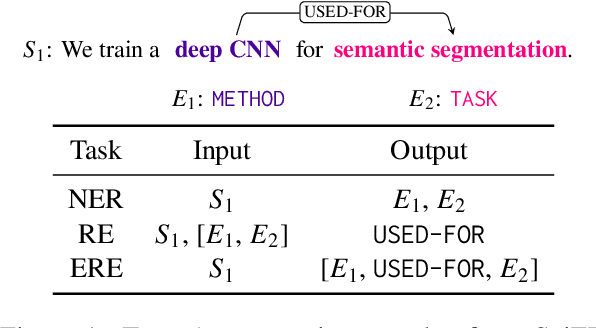
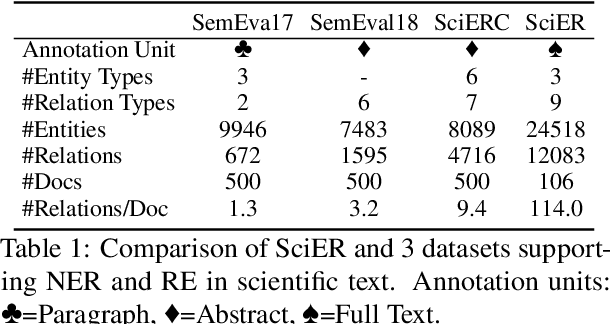


Abstract:Scientific information extraction (SciIE) is critical for converting unstructured knowledge from scholarly articles into structured data (entities and relations). Several datasets have been proposed for training and validating SciIE models. However, due to the high complexity and cost of annotating scientific texts, those datasets restrict their annotations to specific parts of paper, such as abstracts, resulting in the loss of diverse entity mentions and relations in context. In this paper, we release a new entity and relation extraction dataset for entities related to datasets, methods, and tasks in scientific articles. Our dataset contains 106 manually annotated full-text scientific publications with over 24k entities and 12k relations. To capture the intricate use and interactions among entities in full texts, our dataset contains a fine-grained tag set for relations. Additionally, we provide an out-of-distribution test set to offer a more realistic evaluation. We conduct comprehensive experiments, including state-of-the-art supervised models and our proposed LLM-based baselines, and highlight the challenges presented by our dataset, encouraging the development of innovative models to further the field of SciIE.
FlowLearn: Evaluating Large Vision-Language Models on Flowchart Understanding
Jul 09, 2024



Abstract:Flowcharts are graphical tools for representing complex concepts in concise visual representations. This paper introduces the FlowLearn dataset, a resource tailored to enhance the understanding of flowcharts. FlowLearn contains complex scientific flowcharts and simulated flowcharts. The scientific subset contains 3,858 flowcharts sourced from scientific literature and the simulated subset contains 10,000 flowcharts created using a customizable script. The dataset is enriched with annotations for visual components, OCR, Mermaid code representation, and VQA question-answer pairs. Despite the proven capabilities of Large Vision-Language Models (LVLMs) in various visual understanding tasks, their effectiveness in decoding flowcharts - a crucial element of scientific communication - has yet to be thoroughly investigated. The FlowLearn test set is crafted to assess the performance of LVLMs in flowchart comprehension. Our study thoroughly evaluates state-of-the-art LVLMs, identifying existing limitations and establishing a foundation for future enhancements in this relatively underexplored domain. For instance, in tasks involving simulated flowcharts, GPT-4V achieved the highest accuracy (58%) in counting the number of nodes, while Claude recorded the highest accuracy (83%) in OCR tasks. Notably, no single model excels in all tasks within the FlowLearn framework, highlighting significant opportunities for further development.
SciDMT: A Large-Scale Corpus for Detecting Scientific Mentions
Jun 20, 2024



Abstract:We present SciDMT, an enhanced and expanded corpus for scientific mention detection, offering a significant advancement over existing related resources. SciDMT contains annotated scientific documents for datasets (D), methods (M), and tasks (T). The corpus consists of two components: 1) the SciDMT main corpus, which includes 48 thousand scientific articles with over 1.8 million weakly annotated mention annotations in the format of in-text span, and 2) an evaluation set, which comprises 100 scientific articles manually annotated for evaluation purposes. To the best of our knowledge, SciDMT is the largest corpus for scientific entity mention detection. The corpus's scale and diversity are instrumental in developing and refining models for tasks such as indexing scientific papers, enhancing information retrieval, and improving the accessibility of scientific knowledge. We demonstrate the corpus's utility through experiments with advanced deep learning architectures like SciBERT and GPT-3.5. Our findings establish performance baselines and highlight unresolved challenges in scientific mention detection. SciDMT serves as a robust benchmark for the research community, encouraging the development of innovative models to further the field of scientific information extraction.
* LREC/COLING 2024
Enhanced Masked Image Modeling for Analysis of Dental Panoramic Radiographs
Jun 18, 2023Abstract:The computer-assisted radiologic informative report has received increasing research attention to facilitate diagnosis and treatment planning for dental care providers. However, manual interpretation of dental images is limited, expensive, and time-consuming. Another barrier in dental imaging is the limited number of available images for training, which is a challenge in the era of deep learning. This study proposes a novel self-distillation (SD) enhanced self-supervised learning on top of the masked image modeling (SimMIM) Transformer, called SD-SimMIM, to improve the outcome with a limited number of dental radiographs. In addition to the prediction loss on masked patches, SD-SimMIM computes the self-distillation loss on the visible patches. We apply SD-SimMIM on dental panoramic X-rays for teeth numbering, detection of dental restorations and orthodontic appliances, and instance segmentation tasks. Our results show that SD-SimMIM outperforms other self-supervised learning methods. Furthermore, we augment and improve the annotation of an existing dataset of panoramic X-rays.
DMDD: A Large-Scale Dataset for Dataset Mentions Detection
May 19, 2023Abstract:The recognition of dataset names is a critical task for automatic information extraction in scientific literature, enabling researchers to understand and identify research opportunities. However, existing corpora for dataset mention detection are limited in size and naming diversity. In this paper, we introduce the Dataset Mentions Detection Dataset (DMDD), the largest publicly available corpus for this task. DMDD consists of the DMDD main corpus, comprising 31,219 scientific articles with over 449,000 dataset mentions weakly annotated in the format of in-text spans, and an evaluation set, which comprises of 450 scientific articles manually annotated for evaluation purposes. We use DMDD to establish baseline performance for dataset mention detection and linking. By analyzing the performance of various models on DMDD, we are able to identify open problems in dataset mention detection. We invite the community to use our dataset as a challenge to develop novel dataset mention detection models.
Graph Convolutional Networks based on Manifold Learning for Semi-Supervised Image Classification
Apr 24, 2023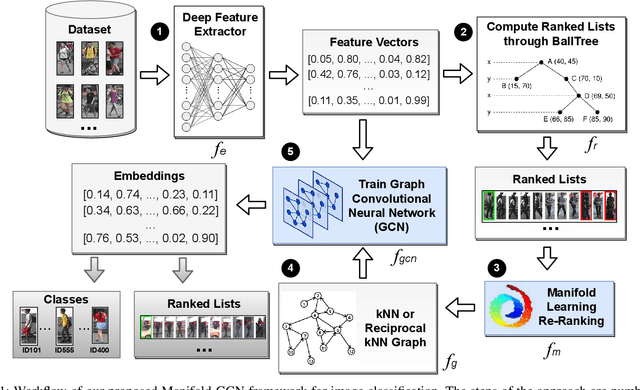
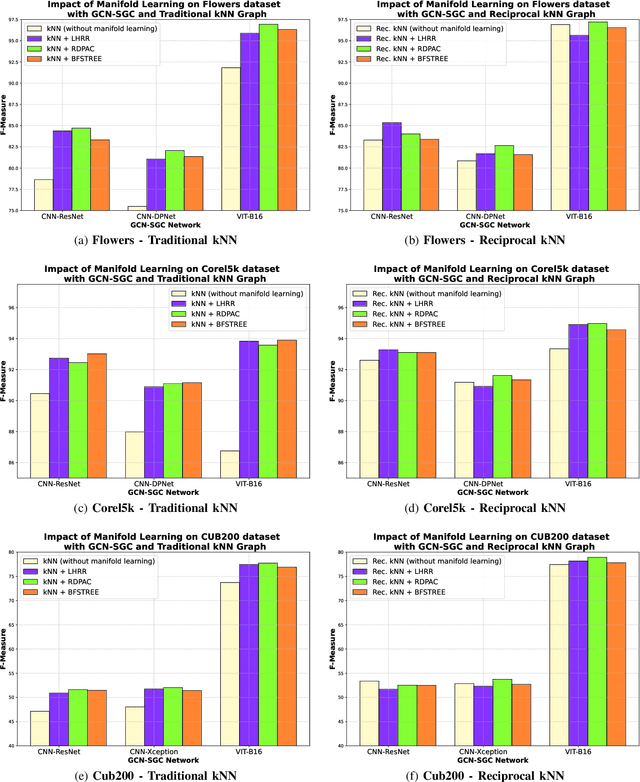
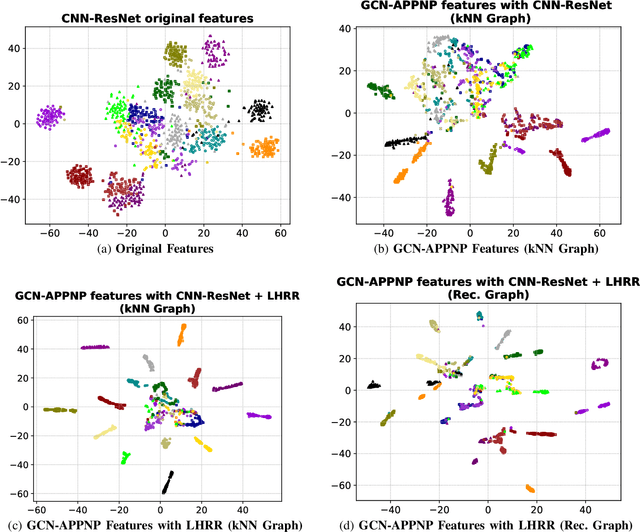
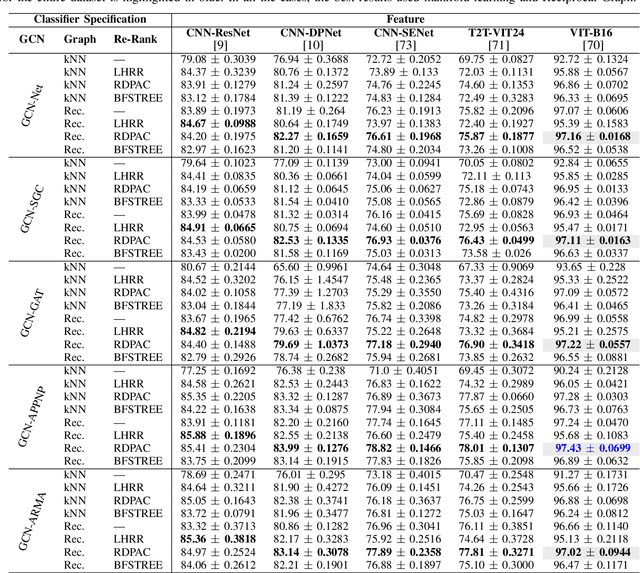
Abstract:Due to a huge volume of information in many domains, the need for classification methods is imperious. In spite of many advances, most of the approaches require a large amount of labeled data, which is often not available, due to costs and difficulties of manual labeling processes. In this scenario, unsupervised and semi-supervised approaches have been gaining increasing attention. The GCNs (Graph Convolutional Neural Networks) represent a promising solution since they encode the neighborhood information and have achieved state-of-the-art results on scenarios with limited labeled data. However, since GCNs require graph-structured data, their use for semi-supervised image classification is still scarce in the literature. In this work, we propose a novel approach, the Manifold-GCN, based on GCNs for semi-supervised image classification. The main hypothesis of this paper is that the use of manifold learning to model the graph structure can further improve the GCN classification. To the best of our knowledge, this is the first framework that allows the combination of GCNs with different types of manifold learning approaches for image classification. All manifold learning algorithms employed are completely unsupervised, which is especially useful for scenarios where the availability of labeled data is a concern. A broad experimental evaluation was conducted considering 5 GCN models, 3 manifold learning approaches, 3 image datasets, and 5 deep features. The results reveal that our approach presents better accuracy than traditional and recent state-of-the-art methods with very efficient run times for both training and testing.
Rank Flow Embedding for Unsupervised and Semi-Supervised Manifold Learning
Apr 24, 2023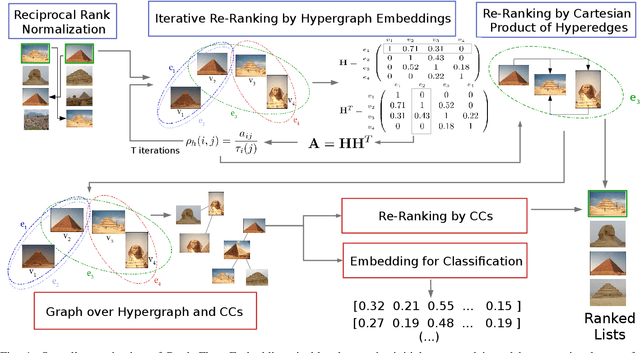
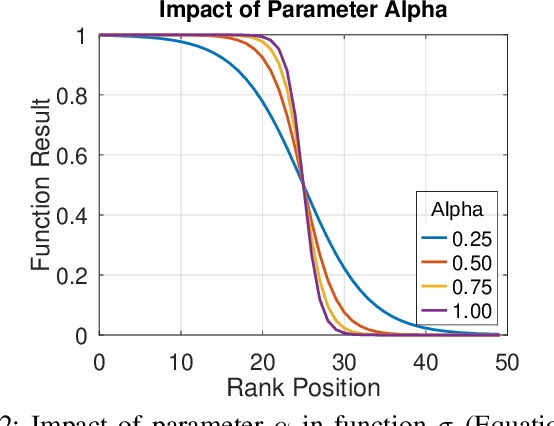
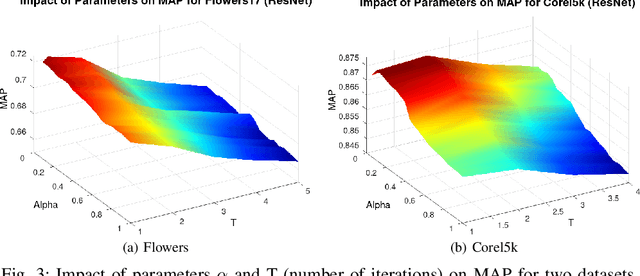
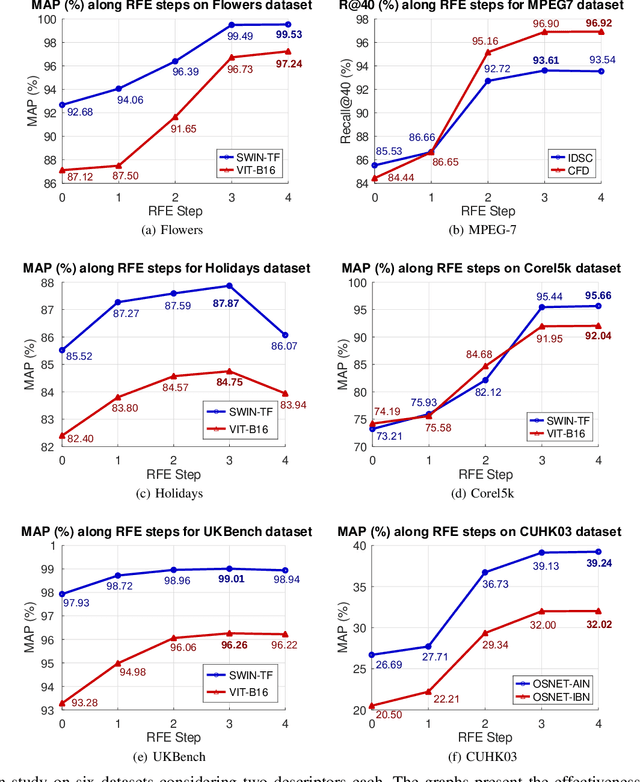
Abstract:Impressive advances in acquisition and sharing technologies have made the growth of multimedia collections and their applications almost unlimited. However, the opposite is true for the availability of labeled data, which is needed for supervised training, since such data is often expensive and time-consuming to obtain. While there is a pressing need for the development of effective retrieval and classification methods, the difficulties faced by supervised approaches highlight the relevance of methods capable of operating with few or no labeled data. In this work, we propose a novel manifold learning algorithm named Rank Flow Embedding (RFE) for unsupervised and semi-supervised scenarios. The proposed method is based on ideas recently exploited by manifold learning approaches, which include hypergraphs, Cartesian products, and connected components. The algorithm computes context-sensitive embeddings, which are refined following a rank-based processing flow, while complementary contextual information is incorporated. The generated embeddings can be exploited for more effective unsupervised retrieval or semi-supervised classification based on Graph Convolutional Networks. Experimental results were conducted on 10 different collections. Various features were considered, including the ones obtained with recent Convolutional Neural Networks (CNN) and Vision Transformer (ViT) models. High effective results demonstrate the effectiveness of the proposed method on different tasks: unsupervised image retrieval, semi-supervised classification, and person Re-ID. The results demonstrate that RFE is competitive or superior to the state-of-the-art in diverse evaluated scenarios.
 Add to Chrome
Add to Chrome Add to Firefox
Add to Firefox Add to Edge
Add to Edge